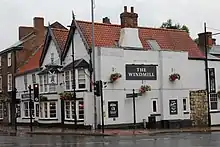.jpg.webp) Looking north-east on Blossom Street | |
Location within York | |
| Former name(s) | Ploxswaingate |
|---|---|
| Location | York, United Kingdom |
| Coordinates | 53°57′18″N 1°05′32″W / 53.9550°N 1.0921°W |
| North east end | Micklegate |
| Major junctions |
|
| South west end |
|
Blossom Street is a road in York, in England, immediately west of the city centre.
History
The street has been the main route leading south and west from York from the Roman Eboracum era onwards; the Roman roads to Calcaria (now Tadcaster) and Isurium Brigantum (now Aldborough, North Yorkshire) ran parallel to the modern road, to the rear of the buildings on its north-western side. While the area was initially agricultural, it was later used as a rubbish dump, and then as a cemetery. Remains of several tombs have been found. By the 5th-century, it appears to have been used as agricultural land once more.[1]
The street was first recorded in the early-13th century, as Ploxswaingate, named for the ploughswains living in the area, and by 1282, 29 plots along the street had already been built upon. Unlike other streets in mediaeval York, it was extremely wide, and as a result, a horse and cattle market was held on it. By 1639, there were 68 houses on the street, and although there was some damage during the 1644 Siege of York, the presence of a nearby Royalist camp meant it was the only suburb of the city to escape complete destruction.[2]
From the Mediaeval period, the street was known for its inns, mixed with smaller merchants' houses and farmhouses belonging to people who put cows out to pasture on the Knavesmire. Barstow's Hospital was built in the 17th-century, and from the 1820s, it became built up with larger houses and shops.[2][3] The last horse fair on the street was held in about 1906, by which time it had become an important tram and bus route.[3] It is now a mixed commercial area, with shops, restaurants, hotels and some housing, although it is dominated by traffic.[1]
Layout and architecture
The street is the continuation of Micklegate. It runs south-west from Micklegate Bar, through a major crossroads with Queen Street and Nunnery Lane. On its south-east side are several terraced streets: St Mary's Court, South Parade, Moss Street and Shaw's Terrace; while only The Crescent leads off its north-west side. Past its junction with Holgate Road and East Mount Road, it continues as The Mount.[2][1]
Notable buildings on the north-east side include the Windmill Inn, with 17th-century origins; 22-26 Blossom Street, built in 1789 by John Horner, which served for much of the 20th-century as the York Railwaymen's Club; and the Everyman Cinema, designed by Harry Weedon in 1936. On the south-west side lie the Bar Convent, the oldest Catholic convent in England; 19 Blossom Street, dating from 1760, but with some earlier material; and the Bay Horse, dating back to the 17th-century.[2][4]
Gallery
.jpg.webp)
.jpg.webp) Various Fast-Food Restaurants
Various Fast-Food Restaurants
 The Windmill
The Windmill.JPG.webp)
 The Crescent
The Crescent
References
- 1 2 3 "Character area 23: Blossom Street/Nunnery Lane" (PDF). City of York Council. Retrieved 28 September 2020.
- 1 2 3 4 An Inventory of the Historical Monuments in City of York, Volume 3, South west. HMSO. 1972. Retrieved 7 August 2020.
- 1 2 A History of the County of York: the City of York. London: Victoria County History. 1961. Retrieved 7 August 2020.
- ↑ Pevsner, Nikolaus (1972). Yorkshire: York and the East Riding (1 ed.). Harmondsworth: Penguin Books. p. 144–145. ISBN 0140710434.